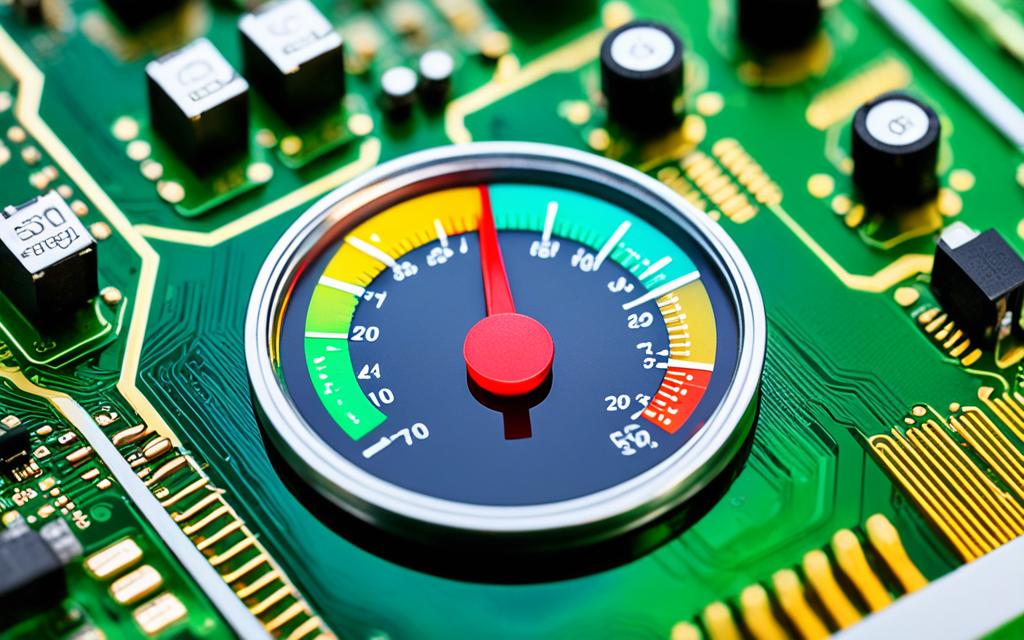Table of Contents
The temperature your CPU works at is vital for its health and how well it performs. Keeping it at the right temperature boosts your system and makes your CPU last longer. Usually, CPUs work best between 40°C and 70°C for everyday tasks.
But if they hit 90°C under heavy loads, you might worry about overheating and damage. It’s very important to regularly check your CPU’s temperature. This helps avoid overheating, which can slow down your computer and break parts. For tips on managing your CPU’s temperature, have a look at recommended CPU temperature guidelines for various situations1.
Key Takeaways
- Optimal CPU temperature ranges from 40°C to 70°C under load conditions.
- Regular monitoring is crucial to prevent overheating and hardware damage.
- Intensive workloads can push CPU temperatures up to 90°C.
- Clean systems with good airflow help maintain lower operating temperatures.
- Using thermal paste effectively is essential for better heat dispersion.
- Consider external cooling solutions for laptops and compact systems.
- Keep an eye on CPU temperatures when performing demanding tasks.
Introduction to CPU Temperature
It’s crucial to understand CPU functionality since it is linked with heat generation. When the CPU works, it produces heat by drawing power. To prevent the system from overhearsing and potential damage, keeping the CPU temperature right is key. Regular checks for any temperature anomalies are needed. This helps in spotting issues like dust build-up or poor cooling that affect CPU performance.
Understanding CPU Functionality and Heat Generation
The CPU is the brain of the computer, managing tasks and processes. It generates heat while it works, so monitoring its temperature is essential. Ideal CPU temperatures are between 40 to 65°C when idle, and 65 to 80°C during heavy use2. For high-end gaming systems, temperatures above 85°C can be harmful over time3.
The Importance of Monitoring CPU Temperature
Keeping an eye on CPU temperature has several benefits. It helps identify problems early on. There are many software tools for this, including ones from Intel and AMD, and third-party apps like Core Temp, HWiNFO, and NZXT’s CAM4. These tools offer features like real-time monitoring and system performance data. Overlooking CPU temperature can cause overheating, efficiency loss, or lasting damage. For more information, visit this resource.
What Is a Good CPU Temperature?
Knowing a good CPU temperature helps keep computers running well for longer. A healthy range is 30°C (86°F) to 40°C (104°F) when idle. Under load, temperatures can rise to 60°C (140°F) to 70°C (158°F), depending on the CPU model and cooling solution5. This knowledge helps keep systems safe, especially when running demanding tasks.
Idle and Load Temperature Ranges
During normal use, CPU temperatures vary from 40°C to 65°C (104°F to 149°F). For heavy tasks like gaming, they may hit 70°C to 80°C (158°F to 176°F)6. Safe operating temperatures are between 40°C to 80°C (104°F to 176°F) for normal activities. With heavy use, they can reach 60°C to 90°C (140°F to 194°F)7. Monitoring these temperatures is key to avoid overheating, which can cause your system to become unstable or perform poorly.
Safe Operating Temperatures for Different CPUs
Most CPUs work fine up to 80°C (176°F). But going over this can cause thermal throttling or damage5. If CPU temperatures are between 80°C to 85°C (176°F to 185°F) without heavy apps running, it’s a sign of cooling problems6. Keeping the CPU clean and checking the cooling system regularly helps manage temperatures efficiently7.
What Temperature Should My CPU Be?
Knowing the right CPU temperature is key to making sure it performs well and lasts long. Keeping it at the correct temperature helps a lot, especially when you’re doing things that need a lot of power.
Typical Temperature Guidelines for Various Tasks
How warm your CPU should be depends on what you’re doing. If you’re not doing much or if the CPU is idling, it should be between 30°C (86°F) and 40°C (104°F)8. For more average use, the safe range is from 40°C to 80°C (104°F to 176°F)7. But, if you’re gaming or video editing, expect it to be between 70°C (158°F) and 80°C (176°F)6.
Once it goes over 80°C (176°F), you might have a problem. That could mean it’s getting too hot and might get damaged if it stays that hot for too long8.
How Overclocking Affects CPU Temperature
Overclocking makes your CPU run faster than its standard speed. It’s a way to boost performance but it also makes the CPU hotter. This heat can push the CPU beyond its normal temperature range7. If your CPU is working really hard, it can get dangerously hot which might harm it over time8.
You need good cooling systems to prevent overheating. Keeping an eye on your CPU’s temperature is extra important when you’re pushing it hard, like during gaming or heavy tasks. This helps keep your CPU running smoothly and protects it6.
How to Check Your CPU Temperature
It’s crucial to monitor your CPU temperature to keep your system safe, especially when it’s under a lot of use. You can check your CPU temperature in two ways: through the BIOS or by using specialized software.
Using BIOS to Monitor CPU Temperature
Using the BIOS is a quick way to see your CPU temperature. Right as your computer boots, you can enter the BIOS setup for an initial temperature reading. Different motherboards show this in their own way, but look for CPU information or hardware monitoring sections. This is a simple approach that doesn’t need extra software. However, BIOS monitoring might not give as much detail as software solutions. Yet, it’s good for a basic idea of your system’s starting temperature.
Third-Party Software Solutions
If you want more detailed CPU temperature info, third-party software is your best choice. Tools like Core Temp, NZXT CAM, HWMonitor, and Open Hardware Monitor give you real-time updates. This is great for heavy gaming. They also have features like temperature logs and alerts for high temperatures. Choose lightweight software to minimize the load on your CPU. For more about these tools, see: check this reference.
| Software Tool | Features |
|---|---|
| Core Temp | Real-time temperature monitoring, log function |
| HWMonitor | Comprehensive system monitoring, graphs |
| NZXT CAM | Customisable interface, hardware monitoring |
| Open Hardware Monitor | Open-source, user-friendly |
Knowing your CPU temperatures helps your system perform better and last longer. Regular checks can spot overheating problems. This might prompt fixes like cleaning your PC or checking the thermal paste. Ignoring these checks could let temperatures get dangerously high. This risks serious harm to your system910,).
Conclusion
Keeping your CPU at a safe temperature is key to keeping your computer running well and lasting longer. The best temperature for CPUs is usually from 61°C to 75°C. But it should never go over 85°C11. By knowing and watching these temperatures, you can stop your computer from getting too hot.
Using tools like BIOS settings or apps like HWMonitor and HWiNFO helps a lot with controlling your CPU’s temperature12. When your computer is not doing much, its temperature should be less than 50°C. When it’s working a bit harder, it should stay under 70°C11. Regular checks and small changes, like where your PC sits and how clean it is, help keep things running smoothly.
Paying attention to the temperatures of both the CPU and GPU lets you make smart choices about cooling and how much your computer has to do11. By keeping an eye on things and taking action when needed, you can enjoy a better and longer-lasting computer experience.
FAQ
What is the optimal CPU temperature range for performance?
The best CPU temperature for work is between 40°C and 70°C when doing normal tasks. If you’re working harder, temperatures might reach up to 90°C. It’s key to keep an eye on this to stop your computer from getting too hot.
Why is it important to monitor CPU temperature?
Keeping track of your CPU’s temperature helps avoid overheating. This overheating can slow down your computer or even harm it permanently. Knowing about CPU heat production is essential for top performance and a long life for your device.
What are the safe idle and load temperatures for my CPU?
When your CPU is not doing much, its temperature should be between 30°C and 40°C. During heavy use, it can jump to 60°C to 70°C. These numbers might change based on the kind of CPU and your cooling setup.
How can different tasks affect CPU temperature?
Certain activities like gaming or video editing make the CPU heat up more. During these tough tasks, its normal temperature is between 70°C and 80°C. If you overclock your CPU, it will get even hotter.
How can I effectively check my CPU temperature?
To see your CPU temperature, you can either look at the BIOS when your computer starts or use tools like Core Temp, HWMonitor, or MSI Afterburner. These programs provide detailed temperature info without overloading your system.
What should I do if my CPU temperature is too high?
If your CPU gets too hot, try cleaning out dust, improving air flow, or getting a better cooling system. You might also need to do less at once or not overclock your CPU until it’s cooler.
Source Links
- https://www.techadvisor.com/article/726264/whats-the-best-cpu-temperature.html – What’s the best temperature for your CPU?
- https://www.wikihow.com/Monitor-CPU-Temperature – How to Monitor Your CPU Temperature: 4 Easy Tools
- https://www.auslogics.com/en/articles/how-to-check-and-monitor-cpu-temperature-on-your-windows-10-11-pc/ – How to Check and Monitor CPU Temperature on Your Windows 10/11 PC?
- https://www.avg.com/en/signal/check-cpu-temperature – How to Check and Monitor CPU Temperature on Windows and Mac
- https://www.shiksha.com/online-courses/articles/all-about-cpu-temperature-range/ – CPU Temperature Range That Must Be Maintained – Shiksha Online
- https://www.avast.com/c-how-to-check-cpu-temperature – How to Check and Monitor Your CPU Temperature
- https://www.linkedin.com/advice/3/what-normal-optimal-ranges-cpu-temperature-different – What are the normal and optimal ranges of CPU temperature for different types of processors?
- https://www.noyafa.com/blogs/knowledge-base/good-cpu-temperature – What Is A Good CPU Temperature? A Guide to Keep Your Processor Cool
- https://www.pandasecurity.com/en/mediacenter/how-to-check-cpu-temp/ – How to Check Your CPU Temperature – Panda Security
- https://softwarekeep.com/blogs/how-to/how-to-check-cpu-temp-in-windows-10-11 – How To Check Your CPU Temperature in Windows 10/11
- https://directmacro.com/blog/post/what-is-optimal-cpu-and-gpu-temp – What Is Optimal GPU Temp and CPU Temperature Range
- https://sciotovalleyguardian.com/2023/09/05/what-temperature-should-my-cpu-be/ – What Temperature Should My CPU Be? – Scioto Valley Guardian








